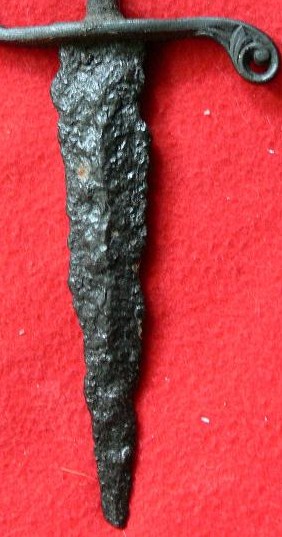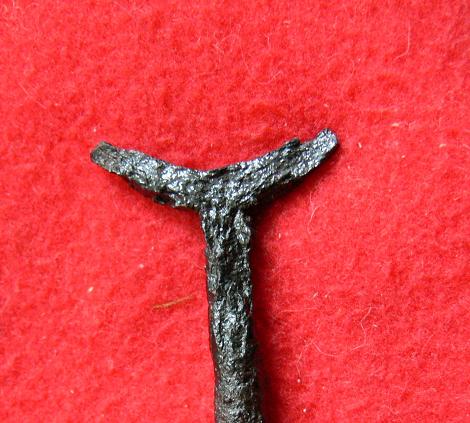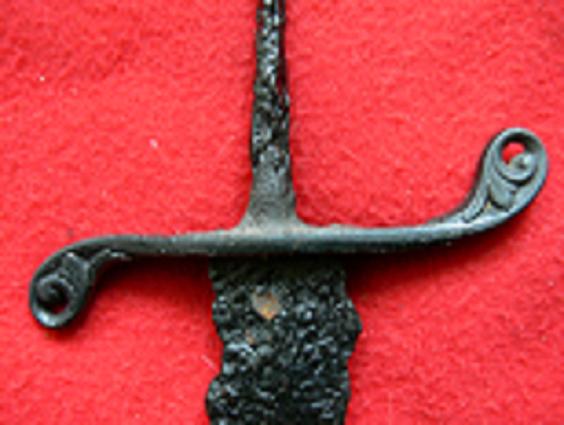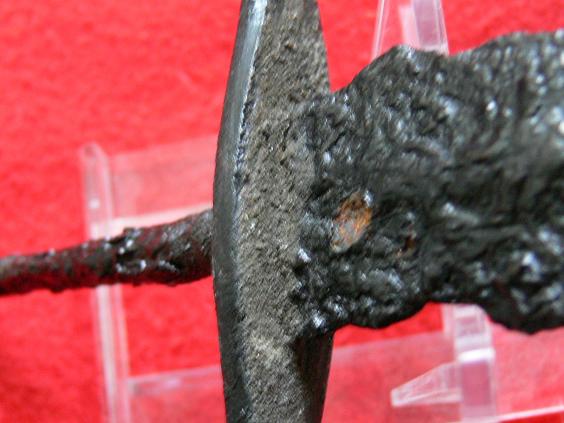Posts: 7 Location: uk
Sat 16 May, 2009 2:00 am
can anyone give me an idea of date ??
Posts: 919
Sat 16 May, 2009 2:03 am
it looks like a medieval dagger coupled to a fancy nineteenth century hilt (cast iron?). How could it be it seems a mistery. Ebay?
Posts: 7 Location: uk
Sat 16 May, 2009 2:04 am
blade
the rusty blade , whole thing has been stabilised but the cross guard seems in much better condition ? seems original to the piece though.
 Attachment: 63.61 KB
Attachment: 63.61 KB

Posts: 7 Location: uk
Sat 16 May, 2009 2:11 am
it came from .......
Posts: 919
Sat 16 May, 2009 2:17 am
There is a garyush substance under and over the cross, where it meets the blade, and on the tang/blade area around. I suspect a rupture. It would be impossible to couple a cross otherwise. Otherwise, how could such a cross have survived intact the conditions that brought the blade almost to fragmentation? Glad to see that you haven't paid much. I think the blade is thirteenth century.
The cross must be cast, you cannot have that detail of foliage in recessed areas by filing.
Posts: 7 Location: uk
Sat 16 May, 2009 2:54 am
many thanks
It was only a buy to decorate the wall so a blade that age will look good on the beams :D
Last edited by Stephen Slade on Sun 17 May, 2009 2:26 am; edited 1 time in total
Posts: 5,981 Location: Birmingham, Alabama
Sat 16 May, 2009 5:41 am
Could have been cast around the tang.
Posts: 21 Location: Minneapolis, MN
Sat 16 May, 2009 6:24 am
It looks like the blade and tang are covered in tar.
Posts: 7 Location: uk
Sat 16 May, 2009 7:18 am
re blade covering
When I used to go metal detecting some people painted their finds to stop further decay, it looks like the same on this blade.
Posts: 208 Location: Melbourne, Australia
Sat 16 May, 2009 4:15 pm
Quite a fascinating piece. I'm guessing there's a really simple answer out there somewhere. I do like the design on the cross guard actually, although it does seem rather 19th century, and would perhaps suit a longer blade.
| Bruno Giordan wrote: |
| how could such a cross have survived intact the conditions that brought the blade almost to fragmentation? |
The cross appears from the photos to be made of some kind of copper alloy. It looks to me to have a slightly green patina. Copper alloys could easily hold up better than steel in these conditions.
Posts: 7 Location: uk
Sun 17 May, 2009 2:25 am
Next Move ??
Hi guys
If I wanted to find out more about this dagger where would I send it and would it cost much ? Can anyone suggest an expert or is it a museum job and wait a year for an opinion ??
I think your comment about a copper alloy may be the answer to this crossguard question. It would have been impressive originally with a polished copper crossguard and shining blade. Maybe a wealthy ladies item ?
Posts: 7 Location: uk
Sun 17 May, 2009 1:49 pm
Armouries
Didn't think of that !!!! I only live 40 miles away from Leeds , thanks for that. Its a fabulous place to visit , I went a couple of months ago
You
cannot post new topics in this forum
You
cannot reply to topics in this forum
You
cannot edit your posts in this forum
You
cannot delete your posts in this forum
You
cannot vote in polls in this forum
You
cannot attach files in this forum
You
can download files in this forum








